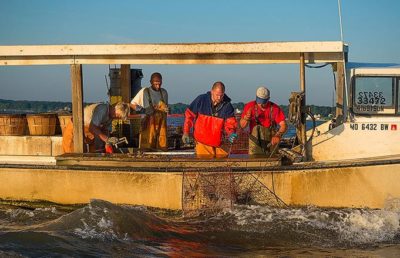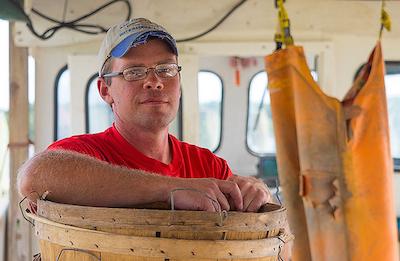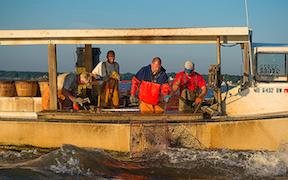C. J. Canby nosed his dead-rise, the Miss Paula, from its berth in Bodkin Creek toward the Chesapeake Bay Bridge. Even though it had rained for almost three weeks, the water was like glass. In a few hours, he would touch seahorses. In a couple of days, he would see a baby crab — fairly unusual for such a northern stretch of water.

The crew aboard Miss Paula pull up some crab pots. (Dave Harp)
“It’s definitely looking like it’s going to be a pretty good year,” said Canby, who fishes 525 pots in the area around Annapolis with his crew of three mates. “It’s been a real good start.”
A good prognosis for Callinectes sapidus is exactly what the experts predicted. The 2016 wintertime survey estimated there were 553 million blue crabs in the Bay, a 35 percent increase from last year’s tally and the highest population in four years. The number of spawning-age females was estimated to be 194 million — below the recommended target of 215 million, but double what it had been the year before.
The comeback for the Bay’s most valuable fishery is yet another sign that harvest restrictions placed on both states in 2008, while painful for the crab industry, may be helping the fisheries bounce back. Among the cuts crabbers absorbed: limits on the number of bushels of female crabs they could take in a day, seasonal closures in Maryland of the fishery for female crabs and a complete closure of the Virginia winter dredge fishery, which overwhelmingly focused on female crabs.
While scientists hoped that crabs would recover quickly and watermen wanted the restrictions loosened, the story wasn’t quite that linear.
The crab population rebounded, more than doubling from 2008 to 2010, but then it slumped again. The juvenile crabs dropped dramatically in 2013, from 581 million to 111 million. Scientists didn’t know the cause, but some watermen suspected many were gobbled up by an influx of red drum into the Bay. Others thought many crabs expired in oxygen-poor water. Whatever the reason, the 2013 results were indicative of a yo-yo population that’s tough to manage.
Crabs are notoriously unpredictable, cannibalistic creatures that typically live less than three years. They reproduce prolifically, but their survival depends on a number of external factors, beginning with favorable winds to blow the larvae back into the Bay after their eggs hatch. They also need thick underwater grasses for habitat; until recently, sediment from rainstorms and algae blooms from excess nitrogen and phosphorus have blocked the light that aquatic vegetation needs to grow.
But this year, researchers at the Virginia Institute of Marine Science and Maryland Department of Natural Resources reported the greatest extent of Bay grasses they’d seen in three decades. Canby and others who frequent the Bay say the water is clearer than they’ve seen in a long time, and data bear that out, at least in some areas of the Chesapeake.
“When Mother Nature is working with us, the best things can happen,” said Brenda Davis, the blue crab manager for the Department of Natural Resources. “It’s a positive turn, and I hope it will be one that is going to last.”
This year, for the first time since 2009, Davis expects the season on female crabs to be extended for three weeks and close Nov. 30 instead of Nov. 10. Crabbers will still be able to harvest males until Dec. 15. Crabbers who fall into some of the license categories where they fish less than 600 pots or trotline will also get a one-bushel increase. Davis predicts the extended season and the modest bushel increase will likely increase the harvest by 5 percent. The change should be official July 1; as the Bay Journal went to press, the department was still awaiting final approval to send out the public notice of the change.

C.J. Canby takes a rest aboard his boat, Miss Paula, after a long morning of crabbing. (Dave Harp)
The management framework for blue crabs allows for state regulators to ratchet the catch up or down depending on what the science and harvest numbers show. In 2014, both Maryland and Virginia tightened their restrictions on taking females when the population appeared to be in trouble again.
Davis said Maryland did not plan to make changes this year in the male harvest, because the data did not show they’d increased that much.
Virginia plans to take up the question of whether to re-open its winter dredge fishery, said Laurie Naismith, spokeswoman for the Virginia Marine Resources Commission. Virginians, particularly watermen on isolated Tangier Island, have been advocating for that since it was closed in 2008. Scientists estimated that the fishery, in which mostly females are scooped up as they slumber on the bottom, was taking about 10 percent of the overall population. Despite earlier upticks in the annual crab survey, the commission has voted to keep it closed.
James “Ooker” Eskridge, mayor of Tangier Island and a longtime crabber, said many of his constituents want to resume the winter fishery. He said he has mixed feelings about it himself, though if it happened he believes it would have to be scaled back from what it was.
But Tom Miller, a longtime crab scientist and director of the Chesapeake Biological Laboratory, contends that reopening the dredge fishery “would be an absolute disaster” because of its likely impact on the female brood stock.
Robert T. Brown, president of the Maryland Watermen’s Association, said he’s been getting good reports on crabbing size and harvest all over the Chesapeake. He said his group will not ask for any more changes until after they see the results of next year’s winter survey, which involves using a dredge to sample 1,500 selected spots around the Bay.
Scientists have long cautioned against relaxing crabbing restrictions too quickly. When the two states came together in 2008, they were already in an emergency situation. Watermen were taking more than 65 percent of the adult population, as opposed to the 50 percent they take now, and the spawning females could not replenish themselves. They bounced back in 2010, only to drop again in 2013.
“One or two years does not make a long-term improvement,” said Anson “Tuck” Hines, director of the Smithsonian Environmental Research Center in Edgewater. Hines, a marine ecologist, would prefer to wait for five or six years of encouraging data before making any changes.
“This is an intense fishery under the best of circumstances and it’s useful to bear that in mind…every time they’re better, everyone wants to back off, and then the next year, things change again,” he said.
Hines suggested the crab population has benefited from a long, cold spring that helped grasses flourish, as well as from catch restrictions. But he cautioned that the population needs more good years in a row before loosening the rules, because the crab’s boom-and-bust cycles do not bode well for long-term survival if managers increase harvest limits too quickly.
For now, the crew on the Miss Paula is enjoying the bounty. Canby’s traps were fuller than any June he recalled. The skittering crabs were a beautiful blue, and so large that his customers were asking him to sort them into several sizes instead of just mixed bushels.
Over the last five years, Maryland’s DNR has encouraged seafood businesses to sell more local crab meat, and advertise when they have it. Many local businesses have done so, putting a “True Blue” sticker on their menus or in their windows.
Last year, Cantler’s Riverside Inn, a popular crab house near Annapolis, had 100 percent local crab meat in August and September, according to manager Bruce Whalen. This year started with only 15 percent local in May, but by early June it was up to 45 percent and climbing.
“They’re getting bigger,” Whalen said of this year’s crabs.
At Eastern Shore Seafood in Onley, VA, CEO Woody Zember has been in business long enough to remember when the crabs coming in “looked like the last pick of the pickle jar.” Not this year, he said. Zember said he’s seeing large, healthy crabs. Most telling, he said, is that they are of uniform size, an indication of enough food and habitat for all.
Zember, who advised the VMRC on catch restrictions almost a decade ago, said fewer crabbers in the fishery has eased harvest pressure on the crab population. In Virginia, anyone wanting to get into crabbing for a living needs to buy a license and the appropriate gear from a crabber ready to retire. The state is not issuing new licenses, Naismith said.
After 2008, many crabbers — particularly those who participated in the winter dredge fishery — found work on tugboats or off the water. That, Zember thinks, gave the population in Virginia a chance to rebound.
With more crabs to catch has come an uptick in crabbing violations. In 2013, the VMRC police made 70 arrests. In 2015, that almost doubled to 132. Most of the arrests came from harvesters taking crabs that were too small.
As in Virginia, Maryland violations have increased. Maryland Natural Resources Police issued 1,142 crab-related warnings and citations in 2013 and 1,922 last year. Undersized crabs accounted for much of the infractions, though in 2015, a fourth of the warnings came from failure to mark collapsible crab traps and net rings.
Maryland also capped the number of crabbing licenses in 1994, though state officials say crabbers who previously caught little have reported sharp harvest increases. Prospective Maryland crabbers can get on a waiting list for a license, or buy one from a retiring crabber.
Better oyster harvests in the last several years have brought more watermen back into the fishery. Some conservationists worry the same thing will happen eventually with crabbing should the population bounce back, but Canby doesn’t think so. It’s hard, unpredictable work, and it’s expensive, he said, what with the price of pots, bait and manpower increasing. And sometimes, the wind blows blustery and the chop doesn’t stop and the equipment breaks down and the person you would call to fix it is…you.
“You gotta love this,” Canby said, “because there’s a lot of better ways to make money.”



Write a Letter to the Editor on this Article
We encourage readers to offer their point of view on this article by submitting the following form. Editing is sometimes necessary and is done at the discretion of the editorial staff.